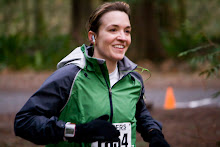Don't.
Stretching after exercise -- cardiovascular and strength training -- is really important. Some say that stretching helps move lactic acid out of your muscles, which prevents soreness. That's never been scientifically proven. But what's clear is that stretching improves flexibility, in your muscles but also in your joints. Flexibility improves your range of motion. In other words, the more limber you are, the more mobile you are.
Some sports medicine experts say you should stretch out for 15-20 minutes after a tough workout. These people must not have jobs or kids or laundry to fold. I'm lucky if I can do between 5 and 10 minutes, but I always stretch after running. I've had too many injuries to mess with the formula.
Here's my routine, cribbed from "The Runner's World Guide to Injury Prevention:"
- Calf stretch: Stand in front of a wall and place both hand on it for support. Take a step back with your left leg and extend it straight. Lean toward the wall so that you feel the stretch, but don't let your ankle collapse. Keep your foot flat on the floor. If your heel wants to come up, take a step in. Then, bend your left leg at the knee, slightly. You'll feel a different and deeper stretch. Hold each stretch for at least 30 seconds and switch legs.
- Hamstring stretch: Rest your heel on a surface about a foot off the floor, but lower than your hips. (A step is perfect, if you're at the gym, a stair is good if you're outside.) Bend the knee slightly and hinge forward at the hips until you feel a stretch in your hamstrings. Hold for at least 30 seconds, switch legs.
- Quadriceps: Stand straight, with your hand on a wall or something sturdy for balance. Bend your left leg and grab your foot, pulling it toward your butt until you feel a stretch along the front of your thigh. Do not arch your back. Hold, switch legs, etc.
- Hip flexor stretch: Stand straight, with a hand on a wall or a chair. Step your left leg forward about two feet, and scootch your right leg behind you so that you're on your toe and your thigh is right under your hip. You should feel a stretch in the front of the right hip. Now, keeping your torso straight, bend both legs. You should feel a deeper stretch along the front of your right hip. Hold, switch legs.
- Glute and hip stretch: This is the one I NEVER skip, because I've had so many hip problems. Lay on your back, on a mat or carpet. Bend your left knee toward your chest and then fan it out to the left, grasping your left foot with your hands. Bring your right knee up until it bisects your left ankle, and then hold that stretch. You can loop your hands around the back of your right leg for extra leverage. Hold this sucker for awhile.
The illiotibial band is connective tissue that runs along the outside of your leg. It's not a muscle, but it definitely can be the cause of knee and hip problems, so it's important to loosen this sucker up if you're feeling tightness in that area.
I've never had success with any of the IT band stretches prescribed to me - it's a hard region to target. So I've got one of those foam roller thingies and I'll position it under my hip right where my leg meets it, and roll it up and down, along the side, to my knee. I warn you, it hurts like a bitch. But it helps.
Another approach is to take a tennis ball and stand next to a wall. Wedge the tennis ball between a tight spot on your hip or glute and the wall, and roll it around. Ouch. But it's like self-massage, and it can be very helpful.
I'll write more this week about other, non-stretching ways to relieve soreness. I got a very weird tip from a massage therapist yesterday. Stay tuned.
